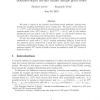106 search results - page 8 / 22 » Proving Lower Bounds Via Pseudo-random Generators |
114
click to vote
ML
2002
ACM
14 years 11 months ago
2002
ACM
We examine linear program (LP) approaches to boosting and demonstrate their efficient solution using LPBoost, a column generation based simplex method. We formulate the problem as...
CORR
2002
Springer
14 years 11 months ago
2002
Springer
Different types of two- and three-dimensional representations of a finite metric space are studied that focus on the accurate representation of the linear order among the distance...
COCO
2003
Springer
15 years 5 months ago
2003
Springer
We study the complexity of building pseudorandom generators (PRGs) with logarithmic seed length from hard functions. We show that, starting from a function f : {0, 1}l → {0, 1} ...
106
click to vote
ECCC
2010
15 years 7 hour ago
2010
We study a variant of the classical circuit-lower-bound problems: proving lower bounds for sampling distributions given random bits. We prove a lower bound of 1 - 1/n(1) on the st...
107
click to vote
JCO
2008
14 years 12 months ago
2008
The problem of partitioning a partially ordered set into a minimum number of chains is a well-known problem. In this paper we study a generalization of this problem, where we not ...

